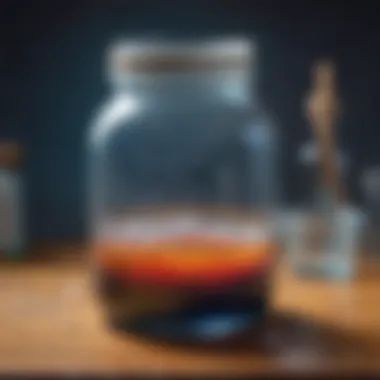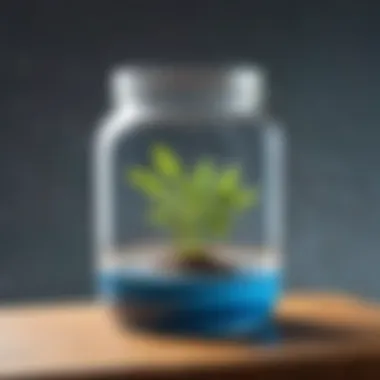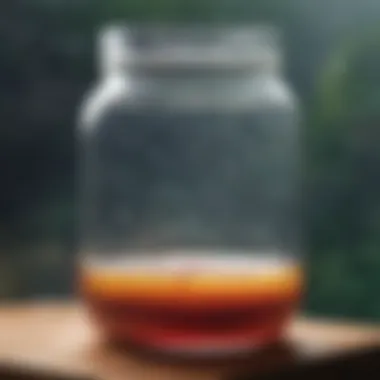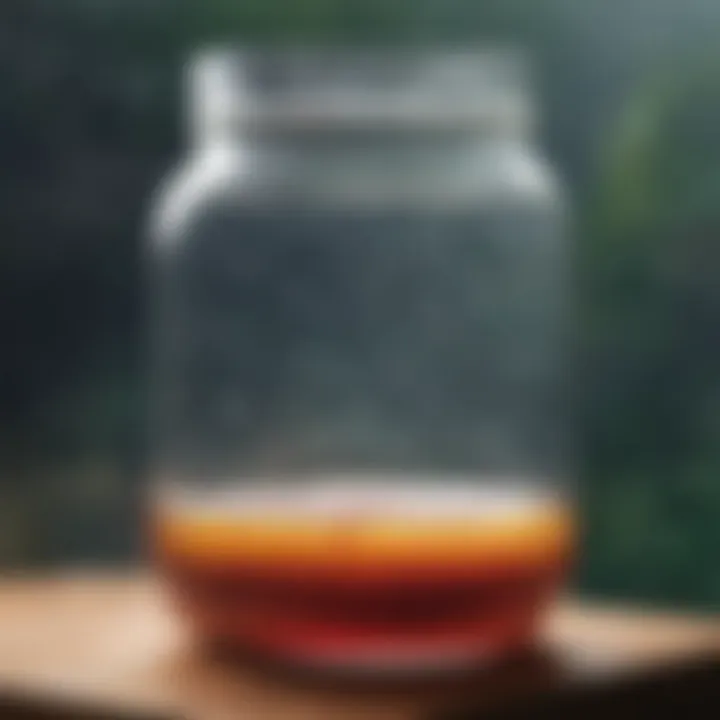Exploring the Rain in a Jar Experiment for Kids


Intro
The 'Rain in a Jar' experiment is a simple yet effective way to introduce young learners to the water cycle. This engaging hands-on activity not only captivates children but also enriches their understanding of scientific principles. In this article, we will explore various aspects of the experiment, including the required materials, detailed instructions, and the science behind the process. By the end, readers will appreciate how such a straightforward experiment can foster a deeper connection to nature and weather phenomena.
Science Fun Facts
Understanding the science behind weather and the water cycle can be fascinating. Here are some interesting facts that can make the concept even more engaging for children:
- Water Cycle: Did you know that the water you drink today could have been part of the rain that fell hundreds of years ago? Water is constantly recycled through the water cycle.
- Evaporation Rates: On a sunny day, water can evaporate from surfaces quickly. In fact, a warm temperature increases the rate of evaporation.
- Cloud Formation: Clouds form when water vapor in the air cools and condenses into tiny droplets. These droplets come together to create visible clouds.
Remember, understanding these concepts can inspire questions about weather patterns and natural phenomena.
Discover the Wonders of Science
Exploring the different scientific concepts surrounding the 'Rain in a Jar' experiment can unlock a world of curiosity for children.
- Exploring Various Scientific Concepts: Children can learn about evaporation, condensation, and precipitation in a fun way.
- Educational Videos and Animations: There are numerous educational resources available, like videos on YouTube or animations on educational websites like Britannica.
- Interactive Learning Tools: Websites like Khan Academy provide excellent learning tools that can enhance understanding of the topic.
- Real-Life Applications of Science: Discussing how the water cycle affects daily weather can make the subject more relevant to children's lives.
Science Experiment Showcase
Fun and Engaging Experiments
The 'Rain in a Jar' experiment is just one of many fun experiments that demonstrate scientific concepts.
Step-by-Step Instructions
- Materials Needed:
- Procedure:
- Observation:
- A clear jar with a lid
- Hot water
- Ice cubes
- Food coloring (optional)
- Fill the jar with hot water until it's halfway full.
- If desired, add a few drops of food coloring to the hot water.
- Place the lid on the jar and turn it upside down.
- Place ice cubes on the lid of the jar.
- After a few minutes, watch as condensation forms on the underside of the lid, resembling rain.
Materials List
- Clear jar with lid
- Hot water
- Ice cubes
- Food coloring (if desired)
Safety Tips and Precautions
- Be cautious when handling hot water to avoid burns.
- Ensure that the jar is stable to prevent spills.
Ending
The 'Rain in a Jar' experiment provides a valuable opportunity for children to learn about the water cycle in a tangible way. Engaging them in this hands-on activity will not only enhance their knowledge but also inspire a lasting interest in science.
Foreword to the Rain in a Jar Experiment
The Rain in a Jar experiment provides a practical way to visualize and understand vital processes in the water cycle. It is particularly well-suited for children aged six to twelve, who often learn best through hands-on activities. This experiment simulates natural phenomena such as evaporation and condensation in a controlled setting, making the abstract concepts of nature more approachable and relatable.
By actively participating in this scientific activity, young learners not only gain knowledge about weather patterns but also develop critical thinking and observational skills. The experiment serves as a catalyst for discussion, encouraging children to ask questions and explore the answers. Moreover, involving parents and caregivers in this educational experience strengthens bonds and fosters a shared appreciation for science.
Overall, the Rain in a Jar experiment offers insights into essential scientific principles while promoting an interactive learning atmosphere. It exemplifies the beauty of discovery through experimentation, laying the groundwork for further exploration in the field of Earth sciences.
Purpose of the Experiment
The primary objective of the Rain in a Jar experiment is to demonstrate how water transitions between different states. It clearly showcases the processes of evaporation, where liquid water transforms into vapor, and condensation, where vapor returns to a liquid state. This experiment effectively illustrates that these processes are fundamental components of the water cycle.
Understanding the water cycle is pivotal for children. It influences weather patterns and affects our daily lives. By conducting the experiment, children can visualize these processes, deepening their grasp of the subject.


Importance of Learning about the Water Cycle
Learning about the water cycle is of utmost importance for several reasons. Firstly, it helps children understand the interconnectedness of natural systems. The water cycle demonstrates how water is reused and recycled, contributing to life on Earth. Grasping this concept fosters a sense of responsibility toward the environment.
Additionally, knowledge of the water cycle prepares children to comprehend more complex climatic phenomena, such as storms and droughts. Understanding these effects can inspire them to think critically about environmental issues facing our planet.
In short, learning about the water cycle nurtures an appreciation for the intricacies of nature, equipping young minds with the tools to navigate and understand the world around them.
Materials Required
Understanding the materials needed for the Rain in a Jar experiment is essential for its effective execution. The right materials ensure that the experiment successfully illustrates the concepts of evaporation and condensation. Each item in the list plays a significant role in demonstrating how water transitions between different states. Moreover, being familiar with these materials helps parents and educators prepare adequately and set clear expectations for young learners.
Before starting, it’s crucial to gather everything necessary. This not only streamlines the process but also reinforces good scientific practices, such as preparation and organization.
List of Materials
Here is a complete list of materials needed for the experiment:
- A clear glass jar or a wide plastic container
- Warm water (not boiling)
- Ice cubes
- A small plate or lid that fits over the top of the jar
- Optional: food coloring to visualize the water
Each item serves a distinct purpose. The jar acts as a mini ecosystem, while warm water simulates the heat from the sun. Ice cubes provide the needed cold temperature to create condensation. The small plate or lid helps capture the water vapor, allowing it to condense. Adding food coloring can enhance visual interest and help kids see the process in action.
Safety Considerations
When conducting any experiment, safety should be a priority, even with seemingly harmless materials. In this case, there are a few simple yet important precautions to take:
- Supervision: Always have an adult present to guide the children during the experiment. This ensures that any potential hazards are managed effectively.
- Hot Water Caution: If using warm water, test the temperature before letting children handle it to avoid burns. It should be warm, not hot.
- Glass Breakage: If a glass jar is used, extra care should be taken to prevent breakage. Ensure the jar is placed on a stable surface.
- Clean Up: Prepare to clean spills immediately to prevent slipping hazards, especially if the experiment is conducted indoors.
By following these safety considerations, the learning experience can be enjoyable and free from accidents. This will help foster a safe environment for exploration, allowing young students to focus on the science behind their observations.
Step-by-Step Instructions
The section on Step-by-Step Instructions is crucial in guiding individuals through the Rain in a Jar experiment. This structured approach ensures clarity and comprehension, especially for young learners. Presenting the experiment in a methodical manner can alleviate confusion, fostering a successful hands-on experience. Each step is designed to demonstrate key principles of the water cycle, allowing participants to witness scientific phenomena in action. Furthermore, this section encourages careful attention to detail, which is an essential skill in scientific inquiry.
Preparation of the Jar
Before executing the experiment, preparing the jar is foundational. Choose a clear glass jar or a similar clear container. The transparency is important as it enables everyone to observe the changes that occur during the experiment.
- Clean the Jar: Ensure the jar is spotless. Any residue could affect the results.
- Fill with Water: Add warm water to about a third of the jar. Warm water enhances evaporation, making the experiment more effective.
- Heat Source: For this step, place a lid or plastic wrap on top to create a seal. This arrangement keeps the moisture contained, aiding in visualizing the condensation process.
- Positioning: Make sure the jar is on a flat, stable surface. This can prevent spills and ensure safety.
Executing the Experiment
Executing the experiment involves observing the interaction between water and temperature. Follow these steps carefully to ensure accurate results and understanding.
Creating the Environment
Creating the Environment is a pivotal aspect of the experiment. A controlled setting allows for the observation of specific changes due to temperature variations. To create the environment:
- Temperature Control: Place the jar in a sunny window or a warm area. The sunlight will heat the water, promoting faster evaporation.
- Covering the Jar: A piece of plastic wrap should be used to cover the top of the jar. This traps the evaporated moisture allowing it to condense on the plastic wrap.
This setup is beneficial as it simulates natural weather processes. The unique feature lies in its simplicity and effectiveness. Yet, too much sunlight can overheat the jar, leading to rapid evaporation and limiting observable condensation.
Observing Changes
Observing Changes is an integral part of the learning experience. This involves actively monitoring the jar for signs of evaporation and condensation. Key aspects to note include the following:
- Condensation Formation: Look for droplets of water forming on the underside of the plastic wrap. This mimics clouds in the atmosphere.
- Water Levels: Notice if the water level changes over time. If more water seems to vanish, that indicates evaporation.
This step allows learners to make real-time connections to the scientific principles they learn in textbooks. Its key characteristic is that it turns abstract concepts into observable realities. However, changes may be subtle at times, requiring patient observation and discussions about the outcomes.
Scientific Principles Illustrated


The exploration of scientific principles through the Rain in a Jar experiment is crucial for understanding fundamental concepts of meteorology and environmental science. This section elucidates the core elements of evaporation, condensation, and the water cycle. Understanding these processes not only enhances the educational experience but also establishes a foundational knowledge for students. Furthermore, it encourages curiosity and promotes scientific inquiry.
Evaporation Explained
Evaporation is the initial stage in the water cycle, where liquid water transforms into vapor. This process occurs when water molecules at the surface gain enough energy to break free and enter the air. In the context of the Rain in a Jar experiment, heat from sunlight or a heat source raises the temperature of the water inside the jar.
Key points about evaporation include:
- Energy Transfer: The process requires energy, often sourced from sunlight or heat sources, which warms the water and increases molecular activity.
- Surface Area Factors: A larger surface area can enhance evaporation rates, making it quicker for water to turn into vapor.
- Temperature Influence: Higher temperatures lead to faster evaporation, as more molecules are energized.
Condensation Process
Condensation is the counterpart to evaporation; it is the process where water vapor cools and turns back into liquid. When the vapor rises and contacts the cooler surface of the jar's lid or sides, it condenses into small droplets. This aspect of the experiment illustrates a vital transition phase in the water cycle.
Aspects of condensation include:
- Cooling Effect: When warm vapor rises and meets cooler air, it loses energy, causing the water molecules to clump together.
- Visible Changes: In the experiment, the droplets of water formed vividly demonstrate this process, providing a tangible example of scientific principles at work.
- Role in Weather: Condensation contributes to the formation of clouds and precipitation, critical elements in daily weather patterns.
The Water Cycle Overview
The water cycle encompasses the continuous movement of water through various states: evaporation, condensation, precipitation, and collection. This cycle ensures the replenishment of water in ecosystems, making it crucial for sustaining life.
Main components of the water cycle are:
- Evaporation: Begins when water from surfaces is heated and converted to vapor.
- Condensation: Occurs when water vapor cools and forms droplets, leading to cloud formation.
- Precipitation: This occurs when droplets grow large enough to fall as rain, snow, or other forms of moisture.
- Collection: Water gathers in bodies of water, promoting another cycle of evaporation.
Understanding the water cycle helps emphasize the interconnection between various environmental processes. It provides a clear view of how simple experiments like the Rain in a Jar can lead to profound insights related to the world around us.
Common Observations
Understanding what to expect during this hands-on activity is beneficial. Children can become more engaged when they see the results of their efforts manifest in a tangible way. This active participation solidifies their grasp of scientific principles. Moreover, observations can lead to discussions about why certain changes occur, prompting further inquiry and exploration of the topic.
Typical Outcomes
During the Rain in a Jar experiment, various outcomes can be observed, demonstrating the basic principles of the water cycle. The most notable result is the formation of condensed droplets on the underside of the jar lid, mimicking the appearance of rain. Typically, participants may witness:
- Evaporation: Water in the jar slowly warms and evaporates, creating vapor.
- Condensation: As the water vapor cools, it condenses into droplets, which eventually fall back into the jar, similar to how rain falls from clouds.
- Temperature Changes: The warmth of the water, combined with the cooler environment created in the jar, can usually be felt as the lid collects moisture.
These outcomes are not only exciting for children but also highlight fundamental concepts in a clear way. This reinforces the idea that water exists in different states and cycles through various processes in nature.
What to Expect
When conducting this experiment, expect a few key observations that align with scientific principles. Initially, the setup may appear simple, but the results can be surprising:
- Physical Changes: Children can expect to see a transformation as water changes from liquid to vapor, and then back to liquid in the form of droplets.
- Quick Learning: Most children understand the concept of rain through this experiment, making it easier for them to relate to daily weather and atmospheric changes.
- Excitement and Engagement: The moment droplets begin to form can ignite curiosity. Children may begin asking questions about why this happens, leading to in-depth discussions.
In summary, the Common Observations section underscores the importance of recognizing outcomes in the Rain in a Jar experiment. These observations serve as a gateway to deeper understanding, engaging young learners in the wonders of the water cycle.
Variations of the Experiment
Engaging in the Rain in a Jar experiment can be further enhanced by introducing various adaptations. These variations not only keep the activity fresh and exciting but also deepen understanding of the water cycle and its components. Exploring different elements or changing the surrounding conditions allows participants to observe a broader range of outcomes. Understanding these variations can encourage children to think critically about scientific processes and the environment.
Adding Different Elements
One straightforward way to modify the experiment is by incorporating different elements into the jar. For instance, adding food coloring to the water can demonstrate how water disperses and changes appearance through evaporation and condensation. You might consider using salt to show how dissolved minerals change the water's properties. Other substances, like sugar, can also be used to illustrate how various materials interact when mixed with water.
This encourages children to ask questions:
- How does the addition of salt or sugar change the evaporation process?
- What did the food coloring do to the visual aspect of the water cycle within the jar?


By varying the elements, participants can see first-hand how different substances might affect the efficiency of evaporation and condensation.
Changing Environmental Conditions
Another fascinating approach is modifying the environmental conditions in which the jar is placed. For example, placing the jar in different locations, such as a sunny windowsill versus a shaded area, can lead to distinct evaporation rates. Likewise, using a heat source, like a lamp, can simulate a warmer climate and affect the experiment's outcome. This method brings real-world relevancy, demonstrating how temperature and light impact weather patterns and the water cycle.
Children might consider questions like:
- How does light influence evaporation in our experiment?
- What happens when we change the temperature around the jar?
By changing the environmental variables, participants learn how these factors can impact weather phenomena and encourages them to connect their findings to real-world scenarios.
In summary, variations in the Rain in a Jar experiment not only enrich the learning experience but also foster critical thinking about the interaction between materials and environmental conditions.
These adjustments are crucial for developing a comprehensive appreciation of the scientific principles at play.
Enhancing Learning Experience
Enhancing the learning experience of children through hands-on experiments is essential. The 'Rain in a Jar' experiment offers not just an activity, but a doorway into the larger concepts of the water cycle, weather phenomena, and scientific inquiry. Engaging young learners with practical tasks cultivates curiosity and encourages analytical thinking.
Related Experiments
There are various experiments that can complement the understanding gained from the 'Rain in a Jar.' These include:
- Simple Water Cycle in a Bag: Using a resealable bag filled with water and a few drops of blue food coloring, children can observe evaporation and condensation occurring over a few days as the bag warms up in sunlight.
- Make a Mini Greenhouse: Placing plants inside a clear container allows children to see the greenhouse effect in action, illustrating evaporation and condensation in a different context.
- Cloud in a Bottle: This experiment involves using a bottle, ice, and a small amount of water to create clouds. As children watch vapor gather and form clouds, they learn about the conditions necessary for cloud formation.
The purpose of these activities is to reinforce scientific principles while allowing the learners to explore different variables in a controlled environment. Each related experiment brings unique insights while contributing to the core ideas learned.
Connecting to Real-World Weather Patterns
Linking the experiment to actual weather patterns helps children understand the relevance of what they observe. Discussing concepts like rain formation, humidity, and temperature variations connects their hands-on experience to the real world.
- Local Weather: Encourage discussions on current weather conditions in their area. Ask students to relate their experiment's findings to actual rain or humid days.
- Seasonal Changes: Discuss how the water cycle operates differently in various seasons and geographic locations. Discuss how areas may experience drought or flooding depending on these changes.
- Global Weather Systems: Introduce simple ideas about how climate zones affect rainfall. For instance, comparing a desert environment to a rainforest can spark interest in how diverse weather patterns are across the globe.
"Understanding weather patterns helps children connect their experiments with phenomena they can see outside. It turns learning into a comprehensive experience."
Connecting what they learn to real-world situations makes science tangible. The experiment helps students not just grasp theoretical concepts but also appreciate the nature in their everyday lives. As they begin to draw conclusions from their observations, they engage more deeply with learning while forging meaningful links between scientific concepts and the world around them.
Reflecting on the Experiment
Reflecting on the Rain in a Jar experiment is vital for reinforcing the concepts learned during the activity. This stage encourages students to consider their observations, and to connect them to broader scientific principles. Reflecting deepens comprehension, turning a simple task into a meaningful learning experience. It serves not just to summarize what happened but also to analyze why certain outcomes occurred, strengthening the overall impact of the experiment.
What We Learned
The Rain in a Jar experiment provides many important lessons. Here are some key takeaways that can emerge from this activity:
- Understanding Evaporation and Condensation: Participants can see firsthand how water changes states. Evaporation occurs when heat causes water to turn into vapor. Conversely, condensation happens when vapor cools down and turns back into liquid. These processes illustrate crucial dynamics of the water cycle.
- Real-World Applications: Children can relate the experiment to real-world weather phenomena, such as rain and clouds. Understanding these processes fuels a curiosity about nature.
- Importance of Observation: This experiment teaches kids to observe changes closely. Noticing small shifts can result in deeper insights about scientific processes.
The act of reflection enables learners to internalize these ideas, promoting a more profound understanding of the water cycle.
Encouraging Further Exploration
The Rain in a Jar experiment can inspire additional inquiries and activities. Encouraging children to ask questions leads to a richer scientific exploration. Here are a few suggested directions for further investigation:
- Conducting Similar Experiments: Students might experiment with various fluids or adding different temperature conditions to the jar. This could lead to discussions about how temperature affects evaporation and condensation.
- Exploring Local Weather Conditions: Linking the experiment to local weather patterns helps ground the learning in reality. Monitoring the weather, observing clouds, and relating it back to their experiment makes science relatable and meaningful.
- Researching the Water Cycle: Engaging in further studies about the water cycle can nurture a love for science. Students can read books, watch videos, or visit educational websites such as Wikipedia or Britannica to learn more.
Encouraging further exploration not only enhances scientific understanding but also fosters a lifelong love of discovery and inquiry.
The End
The conclusion serves as a vital component of understanding the 'Rain in a Jar' experiment. It encompasses the reflections, key insights, and applications derived from the experiment itself. This section brings together all the information discussed and highlights the core concepts that were demonstrated through this engaging activity.
Summary of Key Points
Summarizing the key points reinforces the learning objectives and clarifies the essential aspects of the water cycle, such as evaporation and condensation. It also serves to remind children, parents, and educators of the steps they took and the observations they made. This reinforcement can solidify comprehension of topics related to environmental science. Key points include:
- The transformation of water from liquid to vapor and back again.
- The role of temperature in these processes.
- The importance of the water cycle in our ecosystem.
Additionally, these points allow for critical connections to be made to larger scientific concepts and real-world weather phenomena.
Final Thoughts on Scientific Inquiry
Engaging in scientific inquiry is crucial for developing a deeper understanding of natural processes. The 'Rain in a Jar' experiment encourages curiosity, critical thinking, and hands-on learning. It empowers children to ask questions, make observations, and draw conclusions. This inquiry-based approach nurtures a sense of wonder and promotes further exploration of science and nature. Scientific inquiry fosters skills that are valuable beyond the classroom, contributing to well-rounded problem-solving abilities and analytical thinking.
"Learning through experimentation not only enhances knowledge but also fosters a lifelong passion for discovery."







